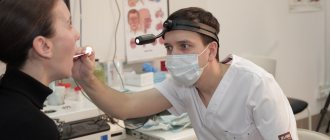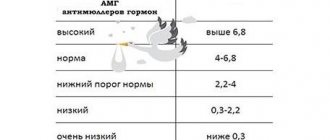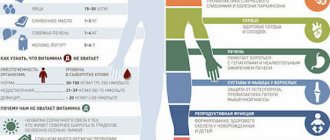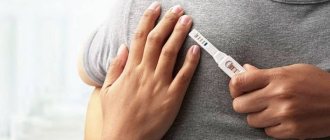Authors of the article: Candidate of Medical Sciences O.Yu. Ermolaev
Gynecologist, ultrasound diagnostics doctor, physiotherapist-resortologist E.K. Ermolaeva
BASAL temperature is the temperature in the VAGINA or anus (RECTAL temperature), measured in the morning from 7.00 to 7.30, after at least 8 hours of sleep, for 10 minutes, with a previously prepared mercury thermometer (thermometer), without getting out of bed, without opening eye.
- Method of measuring basal temperature
- Questions and answers
Basal temperature is an important indicator of hormonal levels and basal metabolism (metabolism at rest).
The purposes of measuring basal temperature and maintaining a basal temperature chart:
- Determine FAVORABLE days for conceiving a child (favorable days for pregnancy).
- Determine UNFAVORABLE days for conception (pregnancy).
- Indirectly determine the state of hormonal levels during PREGNANCY and outside of pregnancy for subsequent in-depth hormonal examination if necessary.
Measuring basal temperature and plotting a graph is based on the hyperthermic effect of PROGESTERONE on the thermoregulatory center of the brain (on the property of progesterone to increase basal temperature).
Any VIOLATION of the subjective state - rhinitis (runny nose), pain of various localization and causes, etc., a hangover, ill health, late rising or going to bed, replacement of a thermometer (thermometer) - should be NOTED on the GRAPH of basal temperature, because These factors can change the temperature in the vagina (rectal temperature) and the basal temperature chart.
With a NORMAL menstrual CYCLE (with a sufficient level and correct ratio of hormones), with ovulation (the release of an egg), the basal temperature graph has TWO clearly defined PHASES of equal duration: a phase of relatively low temperature (below 37.0°C) and a phase of relatively high temperature (above 37.0°C) WITH).
The amplitude (difference) between phases in the ovulatory (with the release of an egg) menstrual cycle is 0.4-0.6 ° C during the day.
A slight amplitude (0.1 - 0.2°C) indicates the absence of ovulation or a violation of the technique for measuring basal temperature.
1-2 days before the onset of menstruation, hyperthermic (relatively high) temperature usually decreases (see Chart 1).
Most authors believe that OVULATION occurs at a MINIMUM (lowest basal temperature) or at the BEGINNING of a progressive Rise of the basal temperature curve, although fluctuations within 3-4 days are possible in relation to the temperature curve.
FAVORABLE days for conceiving a child are precisely these 3 days from the moment the basal temperature rises (increases).
If you do not want to get pregnant during these 3 days, it is recommended to abstain from sexual intercourse without contraception (protection).
Ovulation can occur in some cases at a monophasic basal temperature and be absent, despite the increase in basal temperature in the second phase of the meno-ovarian cycle.
Ovulation in the summer months often occurs in the morning.
Ovulation in the winter months often occurs in the evening.
A healthy woman 18-35 years old with a regular menstrual cycle may have 1-2 anovulatory (without releasing an egg) cycles per year. A healthy woman 36-40 years old can have 2-3 anovulatory cycles per year.
A graph of basal temperature with a slow or stepwise rise in basal temperature indicates insufficient production of progesterone by the ovaries (see Graph 2).
A graph of basal temperature with a monophasic hypothermic basal temperature indicates the ABSENCE OF OVULATION (egg release); see Chart 3.
The graph of basal temperature during PREGNANCY in the case of a sufficient level of progesterone (a hormone that ensures favorable pregnancy) from the first days of pregnancy (even before the delay of menstruation) is characterized by a monophasic hyperthermic curve: basal temperature during pregnancy fluctuates between 37.0 - 37.3 ° C, without falling below 37.0°C.
A decrease in basal temperature during pregnancy below 37.0°C indicates a decrease in the level (content) of progesterone in the blood and is one of the early signs of a threatened miscarriage.
Measuring basal temperature during pregnancy and constructing a graph in order to monitor (observe and identify) early signs of a threatened miscarriage should be carried out at least before 12 weeks of pregnancy.
Measuring basal temperature and plotting a graph in later stages of pregnancy also has diagnostic value.
It is necessary to take into account that acute and chronic diseases in the acute stage cause an increase in body temperature and, accordingly, the temperature in the vagina - basal temperature (see Chart 4).
The graph of basal temperature in case of a violation of the basal metabolism (metabolism at rest), remaining biphasic, can shift relative to 37 ° C upward - with an increase in thyroid function (see Graph 5), or down - with a decrease in THYROID GLAND function (see Graph 6).
Thus, basal temperature, which mainly characterizes the activity of the ovaries, may be an indicator of thyroid dysfunction and other levels of regulation of the menstrual cycle.
Basal temperature measurement
How to measure basal temperature?
Basal temperature is measured only in the MORNING from 7.00 to 7.30 after at least 8 hours of sleep, for 10 MINUTES, with a pre-prepared mercury thermometer (thermometer), WITHOUT GETTING OUT of bed (i.e. before visiting the toilet), WITHOUT OPENING the eyes, in the vagina or in the anus (rectal temperature).
To obtain representative (adequate) data, it is necessary to carry out thermometry always UNIFORMLY: either in the vagina or in the anus.
The use of an electronic thermometer is NOT advisable.
When measuring basal temperature EARLIER 7.00 and LATE 7.30, insufficient duration of night sleep (less than 8 hours), late going to bed (after 23.00), restless sleep with awakenings and/or visits to the toilet, or sleeping in a stuffy (hot) room, duration of thermometry LESS THAN 10 minutes, the presence of infectious and inflammatory diseases and pain of any localization, the basal temperature is not representative (indicative), i.e. Basal thermometry data CANNOT be taken into account when analyzing the basal temperature chart.
Basal temperature is significantly influenced by psycho-emotional stress and insolation (sunbathing and solariums).
The basal temperature chart CAN BE AFFECTED by heat stroke, physical activity, partying the night before, drinking alcoholic beverages, intense sexual intercourse, sleeping in an awkward position, etc.
In order to obtain representative data on basal temperature to determine favorable days for conceiving a child and unfavorable days for conception (pregnancy), it is necessary to keep a graph of basal temperature for AT LEAST three months.
On the basal temperature chart, you should NOTE with symbols or handwritten notes the nature and amount of discharge from the genital tract, changes in daily routine, sexual activity (SEXUAL INTERACT), changes in subjective state (pain, runny nose, flu, acute respiratory infections, sore throat and other changes in health status) .
Norm, deviations and their causes
The above graph is ideal and indicates an absolutely normal course of the cycle. “Incorrect” basal temperature before menstruation can be a sign of pregnancy and certain pathologies:
- Endometritis (inflammation of the uterine mucosa) is manifested by a slight decrease in indicators before the first day of menstruation. During menstruation itself, the temperature is above 37.0 °C.
- Progesterone deficiency, i.e. insufficiency of the second (so-called luteal) phase in the cycle manifests itself as a slow (over three days) increase in temperature with a difference of less than 0.4 degrees. In addition, the duration of the second phase is reduced to ten days. In this situation, periods begin earlier than normal. The increase may remain at the same level for less than a week.
- If the temperature is high and does not change for 18 days, this is one of the signs of pregnancy. In such a situation, menstruation does not occur. Therefore, a woman should definitely take a pregnancy test afterwards.
- In case of inflammation of the appendages (fallopian tubes and ovaries) in the first (follicular) phase, the indicators reach 37.0 ° C within several days. Increased rates are also observed in the next phase. Before menstruation they do not decrease, and during menstruation the temperature is above 37.0 °C.
Leading gynecologist-endocrinologists of Pyatigorsk and KMV
Ermolaeva Elvira Kadirovna is a well-known and recognized specialist in the North Caucasus in the field of preparation for pregnancy, diagnosis and treatment of infertility and miscarriage, fading pregnancy, recurrent miscarriage, management of pregnant women with thrombophilia, antiphospholipid syndrome (APS), systemic lupus erythematosus (SLE), uterine fibroids, management of pregnancy in young and older pregnant women (after 38 years), management of capricious pregnant women, management of pregnant women with excess body weight. A good obstetrician-gynecologist, a specialist in rational nutrition in preparation for pregnancy, a physiotherapist-resortologist, an experienced ultrasound doctor.K It is addressed to women who want to fully prepare for pregnancy and successfully carry a pregnancy to term.
Ermolaev Oleg Yuryevich Candidate of Medical Sciences, gynecologist-endocrinologist with 25 years of experience and successful experience in preparing for pregnancy and managing pregnancy in women with uterine prolapse, bicornuate uterus, saddle uterus and other malformations of the genital organs, managing pregnant women with livedo, thrombophilia and antiphospholipid syndrome (AFS), polycystic ovary syndrome. Management of multiple pregnancies, which require special attention and experience from doctors. Management of pregnancy after IVF, ICSI, after artificial insemination. Management of pregnant women with placental insufficiency. Management of pregnancy against the background of an IUD.
About the doctors of the Clinic in detail...
INTERNATIONAL RECOGNITION of the reputation and achievements of the Women's Health Resort Clinic in the development and implementation of effective and safe treatment methods and the quality of medical services provided is the AWARDING of the Women's Health Resort Clinic in Pyatigorsk with the SIQS International QUALITY CERTIFICATE in the field of medicine and healthcare. International Socratic Committee, Oxford, UK and Swiss Institute for Quality Standards, Zurich, SWITZERLAND. Read more…
We work seven days a week and on holidays:
Monday - Friday from 8.00 to 20.00, Saturday - Sunday from 8.00 to 17.00.
Appointment with a gynecologist-endocrinologist, specialist in proper nutrition in preparation for pregnancy, ultrasound of the pelvis, thyroid gland and adrenal glands by appointment by multi-line phone 8 (800) 500-52-74 (free call within Russia), or +7 (for foreign calls ), or
With mutual respect for the religion and various habits of our patients, we NORMALIZE the menstrual cycle, RESTORE ovulation and endometrial thickness during the “ovulatory window” and achieve SUCCESSFUL pregnancy and the birth of healthy, strong, balanced and open-to-Life children. TO THE JOY of parents and people around you!
We are at your complete disposal if you have any doubts or wishes.
Questions and answers
Question: Where does a gynecologist-endocrinologist see a doctor in Pyatigorsk? M.Kh., Baksan. Answer: A gynecologist-endocrinologist in Pyatigorsk is seen at the Women's Health Resort Clinic at 295 Rifle Division St., 19, building 4, tel. (calls within Russia are free), or +7 (928) 022-05-32 (for international calls), or
Question: My basal temperature DECREASES on the first day of my period, and not before it starts. Is this normal or is it a pregnancy that doesn't last? At the same time, menstruation begins on time. K.Kh., Cherkessk. Answer: A decrease in basal temperature on the first day of menstruation indicates a high level of progesterone until the last day of the cycle, which is a good indicator. However, as you correctly noted, this can also happen with spontaneous MISCARRIORS like menstrual ABORTION. If you suspect spontaneous miscarriages on days 24 and 27 of the menstrual cycle, it is advisable to conduct a blood test for human chorionic gonadotropin (hCG).
Question: Is it possible to get pregnant through intimate intimacy (sexual intercourse) without protection 2-3 days before the onset of menstruation? I have been measuring my basal temperature for 7 months now and ovulation is always on the 14th day. O.Sh., Nalchik. Answer: There is a Coolidge PHENOMENON, according to which an egg can leave the ovary and be fertilized not only on standard days of ovulation, but also with severe irritation of the cervix, even during the premenstrual and menstrual periods. The Coolidge phenomenon explains “unplanned pregnancies” in 5% of women.
Question: Is OVULATION possible at a monophasic temperature? M.E., Zelenokumsk. Answer: In some cases, ovulation can occur at a monophasic basal temperature, which is explained by the Coolidge phenomenon.
Question: I'm very afraid of getting pregnant. My boyfriend says that it is impossible to get pregnant during menstruation. This is true? Z.K., Karachaevsk. Answer: The chance of getting pregnant during menstruation, given the Coolidge phenomenon, is indeed very low.
Question: What does the SMALL DIFFERENCE in basal temperature of the first and second phases mean? (1 - 36.6, 2 - 36.7) In the last cycle there were signs of miscarriage, in this cycle ovulation (test “+”) was at 17 dc. and how does it feel too? M.N., Stavropol. Answer: With a positive ovulation test, a small amplitude of basal temperature indicates an ERROR (violation of the method) of thermometry.
Question: My cycle has always been 26 days, my periods came like clockwork, day after day. I measure my basal temperature and it has always matched my cycle. But this time the temperature sharply increased by 0.3 degrees on the 20th day of the cycle and stayed for 3 days (the pregnancy test was negative). Then the temperature dropped by 0.3 degrees, the next day it rose again, and then my period began. For 2 days I had my period with a temperature of 37, then the temperature subsided as expected. Please tell me what it could be and could there be ovulation on the 20th day of the cycle? V.I., Pyatigorsk. Answer: Ovulation on the 20th day of the cycle is POSSIBLE. In this case, the duration of phase II of the menstrual cycle may increase (the norm is 13-14 days), which is what happened in your case. The reasons for this episode should be discussed with your attending gynecologist-endocrinologist.
Question: How is the gender of a child planned? What tests are needed? How does the service work? G.P., Vladikavkaz. Answer: Planning the sex of the fetus is carried out using the method of mathematical analysis based on the information received from you about previous pregnancies, dates of birth of children, characteristics of menstrual function, etc. No preliminary examination is required. Planning the sex of the fetus is carried out upon the woman’s personal appearance.
Question: Is a consultation with a gynecologist-endocrinologist at the Pyatigorsk Women's Health Resort Clinic possible ACCORDING to the POLICY? Answer: Consultation with a gynecologist-endocrinologist in Pyatigorsk is POSSIBLE under compulsory and voluntary health insurance policies. Pre-registration for an appointment with a gynecologist-endocrinologist is carried out by phone (calls within Russia are free), or +7 (928) 022-05-32 (for foreign calls), or
Question: Tell us how to get an examination with a good gynecologist-endocrinologist at the Women's Health Resort Clinic under the policy? What is needed for this: a referral from an obstetrician-gynecologist, or is just desire and an insurance policy enough? Z.E., Grozny. Answer: To get a consultation with a good gynecologist-endocrinologist under your policy, you should contact your insurance company to receive a cover letter. If you have a cover letter, you will be able to consult a gynecologist-endocrinologist and undergo the necessary examination and treatment in our Clinic. When visiting a gynecologist-endocrinologist, you must have your passport and insurance policy with you. Sincerely, Chief Accountant of the Women's Health Resort Clinic.
Question: What studies are necessary for an appointment and treatment with a gynecologist-endocrinologist? E.M., Makhachkala. Answer: When visiting a gynecologist-endocrinologist, it is advisable to have copies of the results of a previously conducted clinical and laboratory examination (copies of ultrasound, X-ray, computer, laboratory and other studies), copies of consultations with other specialists, copies of epicrises (conclusions) of surgical and conservative treatment. In other words, a consultation with a gynecologist-endocrinologist will be more thorough when providing a full range of medical information about your health condition. If necessary or desired, it is possible to perform an ultrasound of the pelvis, ultrasound of the thyroid gland and ultrasound of the adrenal glands, as well as clinical and laboratory examination in our Clinic.
Question: Does a gynecologist-endocrinologist in Pyatigorsk work on SUNDAY? Zh.S., Prokhladny. Answer: A gynecologist-endocrinologist works for you WITHOUT DAYS OFF: Monday - Friday from 8.00 to 20.00, Saturday, Sunday from 8.00 to 17.00. Appointment with a gynecologist-endocrinologist by appointment.
Question: How does the gynecologist-endocrinologist at the Women's Health Clinic receive treatment during the holidays? M.K., Neftekumsk. Answer: ON HOLIDAYS, a gynecologist-endocrinologist works from 8.00 to 17.00.
Question: How can I make an appointment with a gynecologist-endocrinologist in Pyatigorsk on Saturday? V.S., Mineralnye Vody. Answer: ON SATURDAY, a gynecologist-endocrinologist works from 8.00 to 17.00. Pre-registration for an appointment with a gynecologist-endocrinologist is carried out by phone (calls within Russia are free), or +7 (928) 022-05-32 (for foreign calls), or
Subsections
- Pregnancy management
- Cost of pregnancy counseling
- Screening during pregnancy
- Examination of pregnant women for congenital malformations of the fetus
- Comprehensive assessment of pregnancy markers
- Ultrasound of pregnancy
- Development of pregnancy by week
- Critical periods of embryonic development
- Possible problems during pregnancy
- Proper nutrition during pregnancy
- Hygiene for a pregnant woman
- Sleeping during pregnancy
- Risk factors (caution for pregnant women)
- Determining the sex of the fetus in utero by examining the mother's blood
- Determining acceptable weight gain during pregnancy
- Determining your child's date of birth
- Assessment of fetal movement activity
- Sexual life during pregnancy
- Breathing and relaxation techniques during childbirth
- Literature for preparing for childbirth and raising children
- Premature birth, threatened miscarriage
- The first days after childbirth
- Program No. 7. Postpartum rehabilitation and VUM-building
- Program No. 16. How to remove belly fat
- Breastfeeding or bottle feeding?
- Breastfeeding: problems and rules
- Swaddling a baby
- Let's go to the maternity hospital! Things for mom and baby
- Measuring basal temperature and maintaining a graph
- Teeth and pregnancy
- Our mothers
- School of Natural Motherhood
- Questions and answers about pregnancy
- Reviews about pregnancy management in our Clinic
The essence of the method
During menstruation, basal temperature begins to gradually decrease. This continues until the end of menstruation. Then it stays in the range from 36.3 to 36.6 °C. About two weeks before the start of the next menstruation, ovulation occurs - the release of an egg (oocyte) from the ovary. In this case, the indicators increase to 37–37.3 °C for a period of 1 to 3 days.
After ovulation, the temperature usually remains elevated and remains at this level until the next menstrual cycle, which begins approximately two weeks later (a few days before menstruation, a decrease to 37.0 ° C occurs). But if you become pregnant, it remains high for more than 18 days.
It is often believed that ovulation corresponds to the lowest point of the temperature graph, but this is true for a minority of the fair sex. Most often, ovulation occurs the day before the temperature rises.
How to calculate days favorable for conception
It is possible to calculate days favorable for conception only after analyzing several cycles. Count 3-4 days back from the date when the BT jump occurred, and 2 days forward. This will cover the period of viability of sperm and egg.
Analyze all cycles: for example, in the first, the earliest release of the egg occurred on the 13th day, and in the fourth - on the 14th, thus, the number of days favorable for conception increases. However, if pregnancy does not occur within several months, you should consult a doctor as soon as possible.








